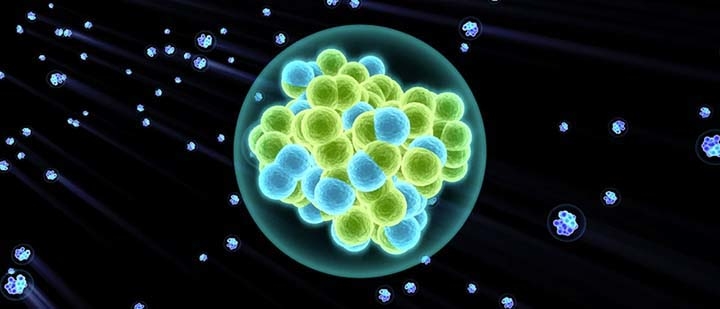Lawrence Livermore credited with discovery of elements 115, 117 and 118
 (Download Image)
Illustration of element 117. Animation by Kwei-Yu Chu/LLNL
(Download Image)
Illustration of element 117. Animation by Kwei-Yu Chu/LLNL
The International Union of Pure and Applied Chemistry (IUPAC) has confirmed that Lawrence Livermore National Laboratory scientists and international collaborators have officially discovered elements 115, 117 and 118.
The announcement means those three elements are one step closer to being named.
Lawrence Livermore teamed with the Joint Institute for Nuclear Research in Dubna, Russia (JINR) in 2004 to discover elements 113 and 115. LLNL worked again with JINR in 2006 to discover element 118. The LLNL/JINR team then jointly worked with researchers from the Research Institute for Advanced Reactors (Dimitrovgrad), Oak Ridge National Laboratory, Vanderbilt University and the University of Nevada, Las Vegas, to discover element 117 in 2010.
"This is a very exciting time for our collaboration and shows that all of the hard work has paid off. It is especially gratifying to receive this news right as we enter a new year," said Dawn Shaughnessy, Lawrence Livermore’s principal investigator for the Heavy Element Group. "I am so proud of all of the hard work that this group has done over the years performing these experiments. Our colleagues in Russia have worked endless hours at the accelerator working toward these results. It is a wonderful gift to the entire group that we are recognized for our efforts in accomplishing these highly difficult experiments and for the years of work it takes to successfully create a new chemical element. Congratulations also to the team in Japan for their efforts in creating element 113. Those were extremely lengthy and difficult experiments and it is a credit to their program to be recognized in this way."
This discovery brings the total to six new elements reported by the Dubna-Livermore team (113, 114, 115, 116, 117, and 118, the heaviest element to date). The IUPAC announced that a Japanese collaboration officially discovered element 113. The LLNL/JINR team had submitted a paper on the discovery of elements 113 and 115 about the same time as the Japanese group.
In 2011, the IUPAC confirmed the name Livermorium for element 116. Livermorium (atomic symbol Lv) was chosen to honor Lawrence Livermore National Laboratory and the city of Livermore, Calif. A group of researchers from the Laboratory, along with scientists at the Flerov Laboratory of Nuclear Reactions at JINR, participated in the work carried out in Dubna on the synthesis of superheavy elements, including element 116. (Lawrencium -- Element 103 -- was already named for LLNL's founder E.O. Lawrence.)
Elements beyond atomic number 104 are referred to as superheavy elements. Although superheavy elements have not been found in nature, they can be produced by accelerating beams of nuclei and shooting them at the heaviest possible target nuclei. Fusion of two nuclei -- a very rare event -- occasionally produces a superheavy element. They generally only exist for a short time.
The discovery of heavier and heavier elements brings researchers one step closer to the "island of stability," a term in nuclear physics that refers to the possible existence of a region beyond the current periodic table where new superheavy elements with special numbers of neutrons and protons would exhibit increased stability. Such an island would extend the periodic table to even heavier elements and support longer isotopic lifetimes to enable chemistry experiments.
Contact
Anne M. Stark[email protected]
925-784-3926
Related Links
International team discovers element 117Livermorium and Flerovium join the periodic table of elements
Interinal Union of Pure and Applied Chemistry
Joint Institute for Nuclear Research
Oak Ridge National Laboratory
Tags
Periodic tablePhysical and Life Sciences
Science
Featured Articles







